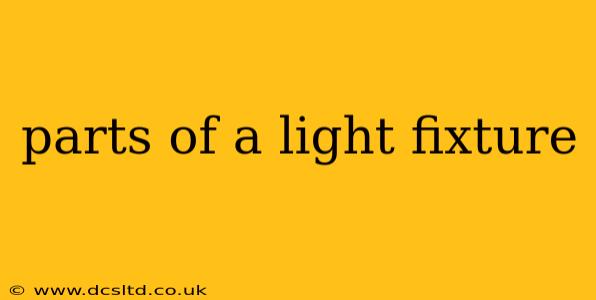Understanding the different parts of a light fixture is crucial, whether you're installing a new one, repairing an existing one, or simply curious about how they work. This comprehensive guide breaks down the key components, explaining their functions and helping you navigate the world of lighting with confidence.
What are the main parts of a light fixture?
Most light fixtures, regardless of style or type, share a common set of core components. These include:
-
The Housing: This is the main body of the fixture, often made of metal or plastic, providing structural support and protection for the internal components. It dictates the overall aesthetic of the light and houses the wiring and other parts.
-
The Socket: This is the part that holds the light bulb. Sockets come in various types, such as Edison screw (E26/E27), bayonet (BA15d), and GU10, each designed to accommodate specific bulb bases. The socket's integrity is critical for safety and proper function.
-
The Wiring: This is the electrical pathway connecting the fixture to the power source. It's crucial for safety to ensure proper wiring is done according to electrical codes. Incorrect wiring can lead to malfunctions and potential fire hazards.
-
The Lamp (Bulb): The light source itself. This can range from incandescent bulbs to LEDs, CFLs, and more, each with its own energy efficiency and light output characteristics.
-
The Mounting Hardware: This includes the parts used to secure the fixture to the ceiling, wall, or other surface. This can include screws, brackets, and mounting plates. Ensuring this is secure is essential for safety.
What are the different types of light fixture sockets?
This is a common question, and understanding the different socket types is vital for choosing the correct light bulb. Common socket types include:
-
Edison Screw (E26/E27): The most common type in North America (E26) and Europe (E27), characterized by a screw-in base.
-
Bayonet (BA15d): A type of socket where the bulb is inserted and twisted to lock into place. Often found in older fixtures.
-
GU10: A two-pin socket commonly used with low-voltage halogen bulbs.
-
G4/G9: Small bi-pin sockets often used in low-voltage halogen spotlights.
What are some common light fixture styles?
There's a vast array of light fixture styles available, each designed for different applications and aesthetics. Some common examples include:
-
Pendant Lights: Hanging lights suspended from the ceiling.
-
Chandeliers: Elaborate hanging fixtures with multiple lights.
-
Flush Mounts: Ceiling fixtures that sit close to the ceiling surface.
-
Semi-Flush Mounts: Similar to flush mounts but with a slightly longer stem.
-
Wall Sconces: Lights mounted on walls.
-
Track Lighting: Systems with multiple adjustable heads mounted on a track.
How do I identify the parts of my light fixture?
The best way to identify the parts of your specific light fixture is by carefully examining it. If you're uncomfortable working with electricity, it's best to consult a qualified electrician. Safety should always be the top priority. Look for labels or markings on the components themselves that might provide clues.
What tools do I need to assemble a light fixture?
The tools you'll need will depend on the specific fixture and your installation requirements. However, common tools include:
-
Screwdrivers (Phillips and flathead): For fastening screws and other hardware.
-
Wire strippers/cutters: For working with electrical wiring (use caution!).
-
Voltage tester: To ensure power is off before working on the fixture.
-
Level: To ensure the fixture is mounted straight.
This guide provides a foundational understanding of light fixture parts. Remember, always prioritize safety and consult a professional if you are unsure about any aspect of installation or repair.
